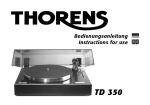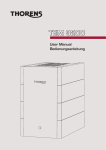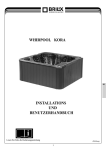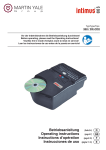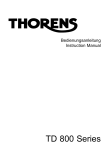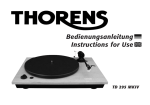Download Thorens TD 2010 audio turntable
Transcript
TD 2010 TD 2030 Bedienungsanleitung User Manual Mode d Emploi www.thorens.com TD 2010 TD 2030 Bedienungsanleitung User Manual Mode d Emploi Inhalt EINLEITUNG 6 SICHERHEITSHINWEISE 7 AUSPACKEN UND MONTAGE 8 AUFSTELLUNG UND ANSCHLUSS 10 INSTALLATION DES TONABNEHMERS 12 EINSTELLUNG DER TONARMHÖHE 13 FEINJUSTAGE DES TONABNEHMERS 14 TONARM TP 250 (TD 2010) 15 TONARM TP 300 (TD 2030) 16 BETRIEB DES PLATTENSPIELERS 17 WARTUNG UND PFLEGE 18 TECHNISCHE DATEN 19 SERVICEINFORMATIONEN 20 Table of Contents Table des matiéres INTRODUCTION 22 INTRODUCTION 38 HINTS FOR SAFETY AND PRECAUTION 23 CONSIGNES DE SECURITE 39 UNPACKING AND ASSEMBLY 24 DEBALLAGE ET MONTAGE 40 PLACEMENT AND CONNECTIONS 26 INSTALLATION ET RACCORDEMENT 42 MOUNTING THE PICKUP CARTRIDGE 28 INSTALLATION DE LA CELLULE DE LECTURE 44 ADJUSTING TONEARM HEIGHT 29 REGLAGE DE LA HAUTEUR DU BRAS 45 ALIGNMENT OF PICKUP CARTRIDGE 30 REGLAGE PRECIS DE LA CELLULE 46 TONEARM TP 250 (TD 2010) 31 BRAS DE LECTURE TP 250 (TD 2010) 47 TONEARM TP 300 (TD 2030) 32 BRAS DE LECTURE TP 300 (TD 2030) 48 OPERATION 33 UTILISATION DE LA PLATINE 49 MAINTENANCE AND CARE 34 MAINTENANCE ET ENTRETIEN 50 TECHNICAL SPECIFICATIONS 35 CARACTERISTIQUES TECHNIQUES 51 SERVICE INFORMATION 36 INFORMATIONS SERVICE APRES-VENTE 52 Einleitung Herzlichen Glückwunsch zum Kauf Ihres neuen TD 2010 / 2030. Wir hoffen, dass Sie mit Ihrem neuen Plattenspieler viel Freude haben werden. In Verbindung mit einem guten Tonabnehmersystem besitzt dieses Laufwerk herausragende Wiedergabequalitäten. Fertigung und Montage erfolgen komplett in Deutschland, so dass Sie sich auch noch nach Jahren auf das Gerät verlassen können. Bitte Denken Sie daran, dass dieser Plattenspieler ein Präzisionsinstrument ist, das stets mit Sorgfalt behandelt werden muss. Wir empfehlen Ihnen daher, diese Bedienungsanleitung vor der ersten Ingebrauchnahme aufmerksam durchzulesen. Sie enthält wichtige Hinweise für Aufstellung, Anschluß und Konfiguration Ihres neuen Laufwerks. Sollten Sie darüber hinaus noch Fragen haben, so können Sie sich jederzeit an Ihren Thorens Fachhändler wenden. 6 Sicherheitshinweise BITTE VOR DER ERSTMALIGEN INBETRIEBNAHME AUFMERKSAM LESEN! VORSICHT Um einen elektrischen Schlag zu vermeiden, darf das Gehäuse des Netzteils nicht geöffnet werden. Im Geräteinneren befinden sich keine vom Benutzer zu wartenden Teile. WARNUNG UM DER GEFAHR VON FEUER UND EINES ELEKTRISCHEN SCHLAGES VORZUBEUGEN, DARF DAS GERÄT WEDER REGEN NOCH FEUCHTIGKEIT AUSGESETZT WERDEN. ERLÄUTERUNG DER GRAFISCHEN SYMBOLE Das Blitz-Symbol mit dem nach unten weisenden Pfeil im gleichseitigen Dreieck warnt vor “gefährlicher Spannung” im Gehäuseinneren, deren Höhe für eine Gefährdung von Personen durch einen Stromschlag ausreichend ist. Das Ausrufezeichen innerhalb des gleichseitigen Dreiecks macht auf wichtige Bedienungs- und Wartungshinweise in der beiliegenden Bedienungsanleitung aufmerksam. Dieses Elektronikprodukt entspricht den gültigen Richtlinien zur Erlangung des CE-Zeichens. Alle notwendigen Prüfungen wurden mit positivem Ergebnis vorgenommen. WICHTIG: ENTSORGUNG VON ELEKTROGERÄTEN DURCH VERBRAUCHER IN PRIVATEN HAUSHALTEN INNERHALB DER EU Dieses Symbol auf dem Produkt oder dessen Verpackung gibt an, dass dieses Produkt nicht zusammen mit dem Restmüll entsorgt werden darf. Es obliegt daher Ihrer Verantwortung, das Gerät an einer entsprechenden Stelle für die Entsorgung oder Wiederverwertung von Elektrogeräten aller Art abzugeben (z.B. ein Werkstoffhof). Die separate Sammlung und das Recyceln Ihrer alten Elektrogeräte zum Zeitpunkt ihrer Entsorgung trägt zum Schutz der Umwelt bei und gewährleistet, dass sie auf eine Art und Weise recycelt werden, die keine Gefährdung für die Gesundheit von Mensch und Umwelt darstellt. Weitere Informationen darüber, wo Sie alte Elektrogeräte zum Recyceln abgeben können, erhalten Sie bei den örtlichen Behörden, Werkstoffhöfen oder dort, wo Sie das Gerät erworben haben. 7 Auspacken und Montage Nehmen Sie das Gerät und die mitgelieferten Einzelteile vorsichtig aus der Verpackung. Lieferumfang: 1 x Bedienungsanleitung 1 x Chassis (mit/ohne Tonarm) 1 x Motor im Standgehäuse 1 x Thorens Antriebsriemen 1 x Plattenteller mit Filzmatte 1 x Tonarmgewicht 1 x Elektronikeinheit PS 800 1 x Netzteil 1 x Netzkabel 1 x Cinchkabel 1 x Adapter für 17 cm Schallplatten 3 x Fußunterlage 2 x Schutzhandschuh ACHTUNG: Die Oberflächen von Chassis und Plattenteller sind sehr kratzempfindlich. Verwenden Sie daher zur Montage unbedingt die beiliegenden Schutzhandschuhe. 8 Legen Sie zunächst die Unterlagen für die Spikespitzen an den Platz, an dem das Laufwerk aufgestellt werden soll. Die Unterlagen verhindern, dass empfindliche Oberflächen durch die Spikes des Plattenspielers beschädigt werden. Stellen Sie den Plattenspieler nun auf diese Unterlagen und richten Sie ihn so aus, dass er waagrecht steht. Sie können die Höhe der Füße anpassen, indem Sie deren Spitzen drehen. Kontrollieren Sie die Höheneinstellung danach mithilfe einer Wasserwaage und korrigieren Sie gegebenfalls. Nun muss der Motor in der dafür vorgesehenen Aussparung links hinten platziert werden. Heben Sie hierfür das Chassis an und positionieren Sie den Motor unter der Aussparung. Senken Sie nun das Chassis langsam ab, so dass sich der Motor von unten in die Aussparung schiebt. Gehen Sie hierbei sehr vorsichtig vor, um die Oberfläche des Plattenspielers nicht zu verkratzen. Die Motoreinheit sollte an ihrer endgültigen Position das Chassis nicht mehr berühren. Setzen Sie nun den Plattenteller vorsichtig in das Lager ein. Achten Sie dabei unbedingt darauf, dass die Achsspitze nicht auf den Lagerboden aufschlägt! Drehen Sie den Teller von Hand und prüfen Sie, ob er sich ohne großen Widerstand drehen lässt. Legen Sie anschließend die Filzmatte auf. Spannen Sie den Riemen um Plattenteller und Riemenscheibe (Abb. 1). Vermeiden Sie Öl- oder Fettspuren auf Antriebsriemen, Motor-Riemenscheibe und der Lauffläche des Plattentellers. Falls notwendig, können Sie diese Teile mit einem in reinem Alkohol getränkten, nicht fasernden Tuch oder Lappen reinigen. Wurde Ihr Plattenspieler ohne Tonarm geliefert, so montieren Sie diesen nun bitte nach der Anleitung des Herstellers. Ansonsten ist der Plattenspieler nun vollständig montiert. Abbildung 1 WICHTIG: Bitte bewahren Sie die Verpackung auf, falls das Gerät einmal zum Transport verpackt werden muss. Für Transportschäden durch unsachgemäße Verpackung wird keine Haftung übernommen! 9 Aufstellung und Anschluss Verbinden Sie das Kabel des Motorgehäuses mit der PS 800 Einheit (Abb. 2.1). ACHTUNG: Bevor der Plattenspieler mit dem Stromnetz verbunden wird, muss der ON/OFF Schalter an der PS 800 Einheit auf „OFF“ und der Geschwinidigkeitswahlschalter auf „33“ gestellt werden (Abb. 2.2). Zum Anschluss an das Stromnetz wird die PS 800 Einheit mithilfe des Netzteils und des Netzkabels mit einer Steckdose verbunden (Abb. 2.3). Abbildung 2.1 Abbildung 2.2 Abbildung 2.3 Abbildung 2.4 ACHTUNG: Trennen Sie niemals den Motorstecker während die PS 800 Einheit eingeschaltet ist, da diese hierdurch zerstört werden kann. Verbinden Sie nun das Kabel des Tonarms mit dem (Phono-) Eingang Ihres Verstärkers (Abb. 2.4). Achten Sie hierbei unbedingt auf eine korrekte Verpolung (linker-/rechter Kanal!) der Anschlüsse. 10 Hinweis: Für Verstärker ohne Phonoeingang wird zusätzlich ein spezieller Phonovorverstärker benötigt. Für Verstärker mit einer 5-poligen Eingangsbuchse nach DIN wird zusätzlich ein spezielles Adapterkabel benötigt. Bitte wenden Sie sich in diesen Fällen an Ihren Fachhändler. Achten Sie bei der Aufstellung Ihres neuen Plattenspielers darauf, einen Mindestabstand zu anderen elektronischen Geräten (z.B. Verstärker, Reciever oder CD-Spieler) einzuhalten, da es sonst zu magnetischen Einstrahlungen auf das Tonabnehmersystem kommen kann, welche sich durch Brummstörungen in der Wiedergabe äußern. Thorens Plattenspieler sind relativ unempfindlich gegenüber Erschütterungen. Dennoch stellen diese ein generelles Problem bei der Plattenwiedergabe mit hochwertigen Tonabnehmern dar. Wählen Sie deshalb ein möglichst stabiles Möbelstück zur Aufstellung und vermeiden Sie die Nähe zu Lautsprechern. Leider reicht dies in älteren Häusern mit Holzbalkendecken bisweilen nicht aus. In der Regel hilft hier allerdings die Aufstellung des Plattenspielers auf einer Konsole, die mit geeigneten Konsolenträgern an einer tragenden Zimmerwand befestigt wird. Magnetische Störungen kann man leicht ermitteln und beseitigen, indem man Aufstellung und Position der Geräte zueinander verändert. 11 Installation des Tonabnehmers Installieren und konfigurieren Sie Ihr Tonabnehmersystem entsprechend der Montageanleitung des Herstellers und nehmen Sie alle notwendigen Einstellungen vor. An den Thorens Tonarmen können Tonabnehmersysteme mit einem standardisierten Abstand der Befestigungslöcher von 12,5 mm (1/2 ”) montiert werden. Im Folgenden erhalten Sie einige Hinweise zur Installation und Konfiguration von Thorens Tonarmen, die analog auch für andere Fabrikate gelten können. Halten Sie sich jedoch im Zweifel immer an die Anleitung des jeweiligen Herstellers. Spezielle Konfigurationshinweise für die Thorens Tonarme TP 250 und TP 300 finden Sie ab Seite 15. Die vier farblich gekennzeichneten Anschlußlitzen werden auf die entsprechenden Anschluß-Stifte (identische Farbe) des Tonabnehmersystems geschoben. R G L G rechter Kanal, rot (Signal) rechter Kanal, grün (Masse) linker Kanal, weiß (Signal) linker Kanal, blau (Masse) Hinweis: Sollte Ihr Plattenspieler mit montiertem Tonarm und Tonabnehmersystem geliefert worden sein, so sind alle Einstellungen bereits werkseitig vorgenommen. Einzig die Auflagekraft muss noch eingestellt werden, da das Tonarmgewicht für den Transport deinstalliert wurde. Ziehen Sie die Montageschuhe zunächst nur lose ab. Die Feinjustage des Tonabnehmers erfolgt nach dem Einstellen der Tonarmhöhe. Montieren Sie den Tonabnehmer in die dafür vorgesehenen Bohrungen des Tonabnehmerkopfs. Belassen Sie dabei den Nadelschutz – wenn möglich – auf dem Tonabnehmer, um Beschädigungen der Abtastnadel zu vermeiden. Hinweis: Bei Grado Tonabnehmern sollten die mitgelieferten Schrauben von unten durch den Tonabnehmer geführt werden und die Mutter oben auf das Headshell geschraubt werden, da sie am Systemkörper nur schwer zu verwenden sind. 12 Einstellung der Tonarmhöhe Drehen Sie nun das Tonarmgewicht in Richtung der Tonarmbank auf den Tonarm (Abb. 3). ACHTUNG: Gehen Sie im Folgenden extrem vorsichtig vor, da jeder Fehler die Abtastnadel des Tonabnehmers zerstören kann! Entfernen Sie vorsichtig den Nadelschutz. Der Tonarm wird anschließend bei abgesenktem Lift zwischen Tonarmstütze und Plattenteller positioniert und durch Verdrehen des Gegengewichtes ausbalanciert. Hinweis: Antiskatingkraft und Auflagekraft (falls diese, wie beim TP 300, nicht durch das Gegengewicht erzeugt wird) sollten hierbei unbedingt auf 0 redurziert werden. Legen Sie nun eine alte Schallplatte auf und senken Sie die Abtastnadel vorsichtig ab. Das Tonarmrohr sollte parallel zur Plattenoberfläche stehen. Ist dies nicht der Fall, so muss die Tonarmhöhe mittels VTA justiert werden. VTA bedeutet Vertical Tracking Adjustment, dieses System ermöglicht es, den Tonarm mithilfe eines Spannmechanismus (Abb. 3) auf die Höhe des jeweiligen Tonabnehmers einzustellen. Abbildung 3 Um die Einstellung vorzunehmen, müssen Sie zunächst die Spannschraube öffnen. Anschließend kann der Tonarm in die gewünschte Höhe gebracht werden. Ziehen Sie die Schraube nun vorsichtig wieder an. 13 Feinjustage des Tonabnehmers Nur bei einer genauen Justage des Tonabnehmersystems kommen die hervorragenden Klangeigenschaften dieses Laufwerks voll zur Geltung. Sollte Sie hierbei Probleme haben, so hilft Ihnen Ihr Fachhändler gerne dabei. ACHTUNG: Bei der Feinjustage des Tonabnehmers ist größte Sorgfalt geboten, damit weder Abtastnadel noch die empfindliche Feinmachanik des Tonarms beschädigt werden. Sollten Sie hierin keinerlei Erfahrung haben, so empfehlen wir Ihnen, dies einem Fachmann zu überlassen. Falsch eingestellte Tonabnehmersysteme können zu starkem Klangverlust bis hin zu Schäden an der Schallplatte führen! Azimut: Dies ist der Winkel zwischen Nadelträger und Schallplattenrille. Er sollte 90° betragen (hiervon ausgenommen sind Systeme, deren Nadel absichtlich schief eingebaut ist). Der Azimut kann am TP 250 und TP 300 nicht eingestellt werden. Sie sollten mit diesen Tonarmen daher nur Tonabnehmer verwenden, die einen korrekten Azimut besitzen. 14 Kröpfungswinkel: Der Kröpfungswinkel ist der Winkel zwischen der Längsachse des Tonabnehmers und der Tonarmachse. Bei allen Drehpunktarmen (wie die Tonarme TP 250 und TP 300) liegen die optimalen Werte zwischen 21° und 24°. Zur Einstellung benötigen Sie eine spezielle Schablone, welche im Fachhandel erhältlich ist. Überhang: Der Überhang ist die Strecke, welche die Tonabnehmernadel über die Plattentellermitte hinausragt. Der Überhang sollte bei den Tonarmen TP 250 und TP 300 ca. 17 mm betragen. Zur Einstellung benötigen Sie eine spezielle Schablone, welche im Fachhandel erhältlich ist. Tonarm TP 250 (TD 2010) Einstellung des Tonarmlifts: Die Lifteinstellung dieses Tonarms wird im Werk vorgenommen und passt für nahezu alle Tonabnehmer. Sollte trotzdem eine Nachjustage nötig sein, wenden Sie sich bitte an Ihren Fachhändler. Einstellung der Antiskatingkraft: Die Antiskatingkraft wird durch den auf der Tonarmbank (2) unter dem Tonarm sitzenden Schieberegler eingestellt. Wir empfehlen, die Antiskatingkraft etwas niedriger als die Auflagekraft einzustellen. Einstellung der Auflagekraft: Informieren Sie sich zunächst darüber, welche Auflagekraft für Ihr Tonabnehmersystem empfohlen wird. Im Allgemeinen sind Auflagekräfte zwischen 10 und 25 mN gebräuchlich (dies entspricht einem Auflagegewicht von 1,0 - 2,5 g). Tonarm TP 250 ➀ ➁ ➂ Tonarmlift Tonarmbank Gegengewicht Hinweis: Wählen Sie die Auflagekraft nicht zu niedrig, da der Tonabnehmer sonst nicht mehr richtig arbeitet. Wenn der Tonarm ausbalanciert ist (siehe Seite 13), können Sie die Auflagekraft durch Drehen des Gegengewichts (3) nach folgendem Schema einstellen: Eine halbe Umdrehung des Gewichts entspricht einer Auflagekraft von 10 mN, eine volle entspricht 20 mN. Drehen in Richtung der Tonarmbank erhöht die Auflagekraft, Drehen in entgegengesetzter Richtung verringert sie. Die grünen Punkte am Gewicht dienen zur Orientierung. Arretieren Sie unbedingt den Tonarm, bevor Sie diese Einstellung vornehmen. ➁ ➂ ➀ 15 Tonarm TP 300 (TD 2030) Einstellung des Tonarmlifts: Die Lifteinstellung dieses Tonarms wird im Werk vorgenommen und passt für nahezu alle Tonabnehmer. Sollte trotzdem eine Nachjustage nötig sein, wenden Sie sich bitte an Ihren Fachhändler. Einstellung der Antiskatingkraft: Die Antiskatingkraft wird durch den auf der Tonarmbank (2) unter dem Tonarm sitzenden Schieberegler eingestellt. Wir empfehlen, die Antiskatingkraft etwas niedriger als die Auflagekraft einzustellen. Hinweis: Wählen Sie die Auflagekraft nicht zu niedrig, da der Tonabnehmer sonst nicht mehr richtig arbeitet. Die Auflagekraft wird durch eine Feder im Inneren des Tonarms erzeugt. Nachdem der Tonarm mittels des Tonarmgegengewichts (3) ausbalanciert wurde (siehe Seite 13), kann diese mit Hilfe des seitlich am Tonarm sitzenden Drehreglers (4) eingestellt werden. Einstellung der Auflagekraft: Informieren Sie sich zunächst darüber, welche Auflagekraft für Ihr Tonabnehmersystem empfohlen wird. Im Allgemeinen sind Auflagekräfte zwischen 10 und 25 mN gebräuchlich (dies entspricht einem Auflagegewicht von 1,0 - 2,5 g). Tonarm TP 300 16 ➀ ➁ ➂ ➃ Tonarmlift Tonarmbank Gegengewicht Drehregler für Auflagekraft Stellen Sie die Auflagekraft auf „0“, bevor Sie den Tonarm ausbalancieren und arretieren Sie diesen anschließend, bevor Sie die Einstellung der Auflagekraft vornehmen. ➁ ➃ ➀ ➂ Betrieb des Plattenspielers Der Motor des Plattenspielers wird über die angeschlossene PS 800 Einheit (Abb. 6) gesteuert. Der rechte Schalter dient zur Geschwindigkeitsauswahl. Folgende Geschwindigkeiten stehen zur Verfügung: 33 ⅓ U/min für Langspielplatten und 45 U/min für kleine Schallplatten. Links daneben befindet sich der ON/OFF Schalter mit dem der Motor an- bzw. ausgeschaltet wird. Zum Abspielen einer Platte wird der Plattenspieler zunächst mit der entsprechenden Geschwindigkeit gestartet. Dann wird der Tonarmlift angehoben, hierzu muss der Hebel nach hinten oben bewegt werden. Nun wird der Tonabnehmer über der Einlaufrille oder über dem gewünschten Stück positioniert und anschließend mithilfe des Lifts auf die Platte abgesenkt (Hebel nach vorne unten bewegen). Abbildung 6 Der Plattenspieler besitzt keine automatische Endabschaltung. Sobald die Auslaufrille erreicht ist, muss der Tonarm mittels Handlift von der Platte gehoben und der ON/OFF Schalter betätigt werden. 17 Wartung und Pflege Ihr Plattenspieler benötigt keinerlei ständige Wartung. Staub, der sich im Laufe der Zeit auf dem Chassis absetzt, kann mit einem weichen und feuchten Tuch entfernt werden. Hinweis: Verwenden Sie zur Reinigung am besten ein feuchtes Brillenputztuch. ACHTUNG: Verwenden Sie zur Reinigung auf keinen Fall ein Papiertuch oder sonstige raufasrige Materialien, da diese die empfindliche Acryloberfläche verkratzen können. Ein trockenes Tuch hingegen kann unerwünschte elektrostatische Aufladungen verursachen. Den Thorens Präzisionsriemen sollten Sie alle 2 Jahre ersetzen. Sollte das Gerät über längere Zeit nicht in Betrieb sein, so empfiehlt es sich, den Riemen abzunehmen, um einer vorzeitigen Alterung vorzubeugen. Bei häufigem Gebrauch sollten Sie alle 5 Jahre eine Überprüfung des Lagers vornehmen lassen und dessen Schmierung erneuern. 18 Technische Daten Modell TD 2010 TD 2030 Antriebssystem Antrieb Riemenantrieb (außenliegend) elektronisch geregelter AC-Synchronmotor 33 ⅓, 45 U/min elektronisch Aluminium 300 mm (12”), 4,5 kg Thorens TP 250 magnetisch keine keine 140 pF PS 800 Elektronikeinheit, landesspezifisches Netzteil 420 x 340 x 160 mm (B x T x H) 18,0 kg Riemenantrieb (außenliegend) elektronisch geregelter AC-Synchronmotor 33 ⅓, 45 U/min elektronisch Aluminium 300 mm (12”), 6,2 kg Thorens TP 300 magnetisch keine keine 140 pF PS 800 Elektronikeinheit, landesspezifisches Netzteil 420 x 340 x 200 mm (B x T x H) 22,0 kg Geschwindigkeiten Geschw.umschaltung Plattenteller Tonarm (standard) Antiskating Automatik Endabschaltung Kabelkapazität Stromversorgung Abmessungen Gewicht Technische Änderungen vorbehalten. Handmade in Germany. 19 Serviceinformationen Ihr Fachhändler oder Vertrieb sind jederzeit kompetente Ansprechpartner, die Ihnen bei sämtlichen Fragen rund um Ihr Thorens Produkt gerne zur Verfügung stehen. Sie können Thorens auch direkt kontaktieren: Thorens Export Company AG Im Huebel 1, CH-4304 Giebenach, Schweiz www.thorens.com, [email protected] Bitte kontaktieren Sie im Garantiefall immer zuerst Ihren Fachhändler oder Vertrieb! Weitere Informationen unter: www.thorens.com/de 20 Notizen 21 Introduction Congratulations for your purchase of the new TD 2010 / 2030. We hope that your new record player will give you lots of listening pleasure. In combination with a good pickup cartridge this turntable is to yield outstanding sound. Manufacturing and assembly of this record player has been carried out in Germany which will guarantee you its high quality and functionality being maintained for many years to come. Please keep in mind that this device is a precision instrument and therefore requires some attention and care. We strongly advise to read these instructions attentively before proceeding with the set-up as it contains all necessary information and guidance for assembly, placement, set-up and configuration of your new record player. In the event that you have any question this user manual cannot answer please do not hesitate to ask your Thorens dealer for further assistance. 22 Safety instructions PLEASE READ THIS PAGE CAREFULLY BEFORE OPERATING YOUR UNIT! CAUTION To reduce risk of electric shock, do not remove the cover (or back). No user-serviceable parts inside. WARNING TO PREVENT FIRE OR SHOCK HAZARD, DO NOT EXPOSE THIS APPLIANCE TO RAIN OR MOISTURE. EXPLANATION OF GRAPHICAL SYMBOLS The lightning flash with arrowhead symbol, within an equilateral triangle, is intended to alert you to the presence of uninsulated ‘dangerous voltage’ within the product’s enclosure that may be of sufficient magnitude to constitute an electric shock to persons. The exclamation point within an equilateral triangle is intended to alert you to the presence of important operating and maintenance (servicing) instructions in the literature accompanying the appliance. This product was tested and complies with all the requirements for the CE Mark. IMPORTANT: DISPOSAL OF WASTE EQUIPMENT BY USERS IN PRIVATE HOUSEHOLDS IN THE EUROPEAN UNION This symbol on the product or on its packaging indicates that this product must not be disposed off with your other household waste. Instead, it is your responsibility to dispose of your waste equipment by handing it over to a designated collection point for the recycling of waste electrical and electronic equipment. The separate collection and recycling of your waste equipment at the time of disposal will help to conserve natural resources and ensure that it is recycled in a manner that protects human health and the environment. For more information about where you can drop off your waste equipment for recycling, please contact your local city office, your household waste disposal service or the shop where you purchased the product. 23 Unpacking and Assembly Carefully remove the unit and its accessories from the shipping box. Supplied items: 1 x user manual 1 x plinth (with/without tonearm) 1 x motor in housing 1 x Thorens drive belt 1 x platter with felt mat 1 x tonearm counterweight 1 x electronic control unit PS 800 1 x mains adaptor 1 x power cord 1 x set of RCA interconnecting leads 1 x adaptor for single records 3 x protective disks 2 x cotton glove ATTENTION: The surface of both plinth and platter is quite sensitive to scratches. It is therefore recommended to wear the supplied gloves whilst the record player is being assembled. 24 Proceed with placing the three protective disks where the record player is eventually going to stay. They are provided to prevent the sensitive surface of furniture from being damaged by the record player’s spiked feet. Now put the record player respectively its feet onto the disks and after the final position has been achieved make sure that the plinth is fairly level. For any fine-adjustments turn the tip of each foot up or down until the plinth is in a perfect horizontal position. This procedure is best controlled (and corrected if necessary) with the help of good spirit level. The motor housing is now to be inserted into the dedicated recess at the rear left corner. This is carried out by having the plinth lifted up and the motor positioned exactly beneath the recess. Slowly lower the plinth so that the motor housing is entering the recess. Great care should be taken while doing this in order to prevent any scratches on the plinth surface. Being in its final position the motor housing should not be touching the inside of the recess. Now take the platter with both hands and hold its axle perpendicular over the hole in the bearing. Slowly and very carefully insert the axle into the bearing while making sure that it must not forcefully hit the bottom of the bearing. After the platter has been put in place turn it manually to see if it runs smoothly and with ease. Add felt mat and finally loop the belt around the outer rim of the platter and the motor pulley (Fig. 1). Avoid any oil or greasy substance to get onto the belt and the transmission area of platter and motor pulley. If necessary you may clean them with a lint-free tissue soaked in an alcoholic dilution (e.g. ethanol). Unless you have acquired your record player with tonearm, you can now proceed with mounting a foreign tone arm according to the instructions supplied by its manufacturer. Otherwise your record player is now completely assembled. IMPORTANT: It is highly recommended to save the shipping box and all packing material in case the record player needs to be packed again for transportation. Fig. 1 Thorens cannot be held responsible for any damage that may occur during transport on the ground that the record player has not been properly packed. 25 Placement and Connections Connect the cord coming from the motor housing to the rear panel of the electronic control unit PS 800 (Fig. 2.1). ATTENTION: Before connecting the record player to the mains power please make sure that the power switch on the PS 800 unit is set to OFF and the speed selector switch set to “33” (Fig.2.2). The PS 800 unit is connected to the mains by using the supplied mains adaptor and the power cord plugged into a wall socket (Fig. 2.3). Fig. 2.1 Fig. 2.2 Fig. 2.3 Fig. 2.4 ATTENTION: Never disconnect the motor plug from the PS 800 unit while it is switched ON. Disregarding this advise may damage the electronic circuitry inside the PS 800. Take the RCA interconnect leads and plug them into the designated (phono) input jacks at the rear side of your amplifier or receiver. Make sure that polarity (left/right channel!) is correct. 26 Hint: if your amplifier lacks a built-in phono stage you need to acquire a special external phono-preamplifier. For amplifiers/receivers featuring a 5-pin DIN-socket at the phono input section you will need a special adaptor (RCA to DIN) which may be available from your Thorens dealer. When placing the record player to its final position make sure that it is a fair distance away from other audio devices, such as amplifier, receiver or CD player. This measure is to avoid electro-magnetic interferences which can yield a distorting effect in the sensitive pickup cartridge, which may be audible as hum during playback. Electro-magnetic interferences however can be disclosed and eliminated by simply changing the position of the record player with respect to the other devices. Thorens record players are relatively insensitive when subject to foot-fall shocks or airborne resonance. Nevertheless, a general problem remains when it comes to playing back vinyl records with a high-quality pickup cartridge. It is therefore highly recommended to choose a sturdy piece of furniture for placement and to avoid the proximity of the record player to the loudspeakers. Under certain circumstances all these precautions may not be good enough in older houses with wooden floor construction. Here, in most cases a solid shelf firmly mounted to a supporting wall can be very beneficial for the sonic properties of the record player if it is placed on such a shelf or console. 27 Mounting the pickup cartridge You can now mount and adjust your pickup cartridge according to the instructions provided with the pickup or with the tonearm. In the following chapters you’ll find some comprehensive hints and advise concerning the correct mounting of Thorens tonearms. They may accordingly be used for mounting foreign tonearms as well, yet if in doubt you should in any case resort to the original instructions provided by the manufacturer of the tonearm. Special hints about the configuration of the Thorens tonearms TP 250 and TP 300 are to be found on page 31-32 of this manual. Hint: If you happen to have acquired this record player as a complete system, i.e. with tonearm and pickup cartridge, there are no adjustments necessary because everything has already been carried out for you in the Thorens factory. Only the tracking force needs to be adjusted. Mount the pickup cartridge to the slots in the tonearm’s headshell. While doing this basic work it is recommended to leave the stylus guard attached to the cartridge in order to avoid damaging of the delicate stylus and cantilever. 28 Thorens tonearms will accept any pickup cartridge with the standard fixing hole distance of 12.5 mm (1/2 ”). Carefully and with the help of tweezers the four colourcoded litz wires coming from the tonearm’s headshell are attached to the respective pins (identical colours) at the rear face of the cartridge. R G L G right channel, red (signal) right channel, green (ground) left channel, white (signal) left channel, blue (ground) For the time being do not tighten the headshell screws. Fine-adjusting and fixing the cartridge is done after having determined the final tone arm height. Hint: If Grado pickup cartridges are going to be employed it is recommended to fix the cartridge with the screws “upside down”. This means that the screws are inserted from underneath through the holes of cartridge and headshell whereby the nuts are to fix the screws on top of the headshell. Adjusting tonearm height The counterweight is attached to the rear end of the tonearm by some slight pressure and a clockwise rotation towards the tonearm’s bearings (Fig. 3). ATTENTION: Great care is necessary for the following mounting and adjust-ment procedures, because the slightest mistake may damage the stylus and cantilever of your pickup cartridge. Carefully detach the stylus guard from the cartridge. Lower the lift lever and move the tonearm to a position in between tonearm rest and the outer rim of the platter. Now balance the tonearm by rotating the counterweight either clockwise or counter-clock-wise until total equilibrium has been achieved. Hint: anti-skating force as well as tracking force (unless it is generated by the counterweight like with the TP 250) must in any case be set to “0”. Put an old, worn record onto the platter and lower the tonearm by the lift lever. The tonearm tube should then be parallel to the record (to be visualised from the side). If this is not the case the so-called Vertical Tracking Angle (VTA) should be adjusted. Fig. 3 A special clamp mechanism (Fig. 3) however allows to individually adjust the VTA according to the size of the mounted pickup cartridge. Adjustments are made by simply loosening the screw of the clamp mechanism and carefully sliding the entire tonearm slightly up or down. Before doing so we advise to move the tonearm back onto its rest. After the correct position for the VTA has been found the clamp screw is to be tightened again. 29 Alignment of pickup cartridge Only a painstakingly aligned pickup cartridge is able to compliment the outstanding sonic capabilities and potential of this record player. If you consider the alignment too difficult to be carried out by yourself, do not hesitate to ask your Thorens dealer for a helping hand. ATTENTION: When aligning the cartridge great care is once more obligatory in order to avoid that the delicate stylus or sensitive parts of the tonearm are being damaged. If you are a newcomer without any experience it is better to leave this work to an expert who knows the specific characteristics of most cartridges. A badly aligned pickup cartridge will be well on the way to yield bad sound and to damage your records! Azimuth: This is the angle between cantilever and record groove. It should be exactly 90° (excluding those cartridges in which the cantilever has purposely been installed with a slight offset). Azimuth can be adjusted neither on the TP 250 nor on the TP 300. It is therefore most important that a cartridge with precise azimuth is going to be mounted. 30 Offset: this is the angle between the longitudinal axis of the pickup cartridge and the tonearm’s longitudinal axis. In all pivoted tonearms (like TP 250 and TP 300) the optimum angle is to be found between 21° and 24°. The special cartridge alignment gauge required for this adjustment may be available from your Thorens dealer. Overhang: this is the distance between the stylus tip and the centre of the platter spindle. For the TP 250 and TP 300 the overhang should be 17 mm. The special cartridge alignment gauge required for this adjustment may be available from your Thorens dealer. Tonearm TP 250 (TD 2010) Adjusting the tonearm lift: It has already been adjusted in the factory and can be considered suitable for nearly all pickup cartridges in the market. However in the unlikely case that the tonearm lift needs to be re-adjusted to fit a special cartridge please contact your Thorens dealer. Anti-skating force (bias): This is adjusted by shifting the button on the tonearm’s lift bench (2). It is recommended to set the anti-skating force slight below the value of the tracking force. Adjustment of tracking force: Make sure to inquire the recommended tracking force for your pickup cartridge from either the cartridge manufacturer or by consulting the mounting instructions supplied with the cartridge. Tracking force is usually adjusted between 10 and 25 mN (corresponding to 1.0 and 2.5 grams). Tonearm TP 250 ➀ ➁ ➂ tonearm lift lever tonearm bench counterweight Hint: Do not set too low a tracking force, because this may prevent the pickup car-tridge from tracking properly. After the tonearm has been correctly balanced (see page 29) you can apply the tracking force by rotating the counterweight (3) according to the following scheme: a half turn of the counterweight corresponds to a tracking force of 10 mN (1.0 g) whereby a full turn corresponds to a force of 20 mN (2.0 g). Turning the counter-weight towards the bearings will increase tracking force, whereas turning the weight into the opposite direction will decrease it. Make sure that the tonearm is kept in its armrest before doing these adjustments. ➁ ➂ ➀ 31 Tonearm TP 300 (TD 2030) Adjusting the tonearm lift: It has already been adjusted in the factory and can be considered suitable for nearly all pickup cartridges in the market. However in the unlikely case that the tonearm lift needs to be re-adjusted to fit a special cartridge please contact your Thorens dealer. Anti-skating force (bias): This is adjusted by shifting the button on the tonearm’s lift bench (2). It is recommended to set the anti-skating force slight below the value of the tracking force. Adjustment of tracking force: Make sure to inquire the recommended tracking force for your pickup cartridge from either the cartridge manufacturer or by consulting the mounting instructions supplied with the cartridge. Tracking force is usually adjusted between 10 and 25 mN (corresponding to 1.0 and 2.5 grams). Tonearm TP 300 32 ➀ ➁ ➂ ➃ tonearm lift lever tonearm bench counterweight anti-skating dial knob Hint: Do not set too low a tracking force, because this may prevent the pickup cartridge from tracking properly. Tracking force is applied by a spring inside the bearing assembly. After the tonearm has been correctly balanced (see page 29) you can adjust the tracking force by turning the dial knob (4) at the bearing assembly. Set tracking force dial to “0” before balancing the tonearm and make sure the tonearm is kept in its armrest before proceeding with these adjustments. ➁ ➃ ➀ ➂ Operation The motor of the record player is electronically controlled by the connected PS 800 unit (Fig. 6). The toggle switch on the right is for selecting the speed whereby two speeds are available: 33 ⅓ rpm for long playing records and 45 rpm for singles. The toggle switch on the left labelled ON/ OFF is to start or stop the motor. For playing a record the turntable is first started with the desired speed. Then lift the tonearm by slowly pushing the lift lever up and back. Release the tonearm from its rest and position it above the lead-in groove or above the desired piece/track to be played. Slowly bring the lift lever to the down-position whereupon the tonearm is smoothly descending. Fig. 6 This record player does not feature any automatic end-ofrecord shut-off facility. Therefore, as soon as the stylus has reached the lead-out groove, the tonearm is to be lifted up manually by the lever and the motor switched off. 33 Maintenance and Care Your record player requires no particular maintenance. If over the time dust has collected on the plinth you can wipe it off with a moistened cloth. Hint: A pre-moistened cleaning tissue for glasses is a very good choice for doing this. ATTENTION: Do not use paper tissue or any coarse-fibred cloth because they may leave scratches on the rather sensitive acryl surface. Also refrain from using a dry cloth for cleaning because this will in any case generate undesired static charges. The Thorens precision belt should be exchanged at least every other year. If the record player is not in use for a longer time, it is advisable to remove the belt in order to prevent a premature ageing under tension. If the record player is frequently in use it is recommended to have the bearing checked and lubrication renewed after about 5 years. 34 Technical Specifications Model TD 2010 TD 2030 Drive system Motor belt drive (via platter rim) electronically controlled AC synchronous motor 33 ⅓ and 45 rpm electronically aluminium 300 mm (12”) 4.5 kg Thorens TP 250 magnetic n/a n/a 140 pF PS 800 electronic control unit country-specified mains adaptor 420 x 340 x 160 mm 18.0 kg belt drive (via platter rim) electronically controlled AC synchronous motor 33 ⅓ and 45 rpm electronically aluminium 300 mm (12”) 6.2 kg Thorens TP 300 magnetic n/a n/a 140 pF PS 800 electronic control unit country-specified mains adaptor 420 x 340 x 200 mm 22.0 kg Speed Speed change Platter Tonearm (standard) Anti-skating Automatic functions Automatic shut-off Capacity of leads Voltage/Power supply Dimensions (WxDxH) Weight Technical modifications subject to change. Handmade in Germany 35 Service Information Your Thorens dealer or distribution partner shall be pleased to assist you in the event that you have any further queries or need additional information concerning Thorens products. You may contact Thorens also directly: Thorens Export Company Ltd. Im Huebel 1, CH-4304 Giebenach, Switzerland www.thorens.com, [email protected] In case of warranty claims you are kindly requested to first contact your Thorens dealer or distributor. Further information may also be obtained from: www.thorens.com 36 Notes 37 Introduction Félicitations pour l’achat de votre nouvelle platine TD 2010 / 2030. Nous espérons que vous aurez beaucoup de plaisir avec l’utilisation de votre nouvelle platine. Equipée d’une cellule de lecture de bonne qualité, cette platine vous offrira une excellente qualité de reproduction. La fabrication et le montage sont entièrement effectués en Allemagne, ce qui vous garantit un usage satisfaisant pour de longues années. Veuillez lire avec attention la totalité de ce mode d’emploi avant la première mise en service. Il contient d’importants conseils pour l’installation, le raccordement et la configuration de votre nouvelle platine. N’oubliez jamais que cette platine est un instrument de précision, qui doit toujours être manipulé avec précaution. Si vous aviez des questions dont les réponses ne se trouveraient pas dans ce mode d’emploi, veuillez vous adresser à votre revendeur. 38 Consignes de sécurité A LIRE ATTENTIVEMENT AVANT LA PREMIERE MISE EN SERVICE! ATTENTION Pour éviter tout choc électrique, le boîtier de l’alimentation ne doit pas être ouvert. A l’intérieur de l’appareil ne se trouve aucune pièce nécessitant un entretien de la part de l’utilisateur. AVERTISSEMENT POUR EVITER TOUT DANGER D‘INCENDIE ET DE CHOC ELECTRIQUE, L‘APPAREIL NE DOIT PAS ETRE EXPOSE A LA PLUIE ET A L‘HUMIDITE. EXPLICATION DES SYMBOLES GRAPHIQUE Le symbole éclair avec flèche vers le bas dans le triangle avertit d‘une „tension dangereuse“ à l‘intérieur de l‘appareil, dont le niveau est suffisant pour présenter un danger de choc électrique aux personnes. Le point d‘exclamation à l‘intérieur du triangle indique des instructions de commande et d‘entretien figurant dans le présent mode d‘emploi. Ce produit électronique est conforme aux directives européennes pour l‘obtention de la marque CE. Tous les essais nécessaires ont été effectués avec un résultat positif. IMPORTANT: ELIMINATION D‘APPAREILS ELECTRIQUES PAR LES UTILISATEURS PARTICULIERS RESIDANT DANS LA CE Ce symbole, figurant sur le produit ou sur son emballage, indique que ce produit ne doit pas être éliminé avec les ordures ménagères. Il est de votre responsabilité de remettre ce produit à une entreprise d‘élimination ou de recyclage d‘appareils électriques de tous types (par ex. une décharge spécialisée) La collecte sélective et la réutilisation de tous vos anciens appareils électroniques à l‘occasion de leur élimination, contribuent à la protection de l‘environnement et assure qu‘il soient recyclés de manière à éviter de porter atteinte à la santé humaine et à la protection de la nature. Pour obtenir de plus amples informations sur les dépôts et le recyclage des appareils électroniques usagés, adressez-vous aux autorités locales, aux déchèteries ou au distributeur qui vous a vendu l‘appareil. 39 Déballage et montage Sortez l‘appareil et les pièces livrées de l‘emballage avec précaution. Contenu: 1 x Mode d‘emploi 1 x Châssis (avec/sans bras de lecture) 1 x Moteur dans le boîtier 1 x Courroie d‘entraînement Thorens 1 x Plateau avec feutre 1 x Poids du bras de lecture 1 x Unité électronique PS 800 1 x Alimentation 1 x Cordon secteur 1 x Câble Cinch 1 x Adaptateur pour disques 17 cm 3 x Embase de pied 2 x Gants de protection ATTENTION: Les surfaces du châssis et du plateau sont sensibles aux rayures. Utilisez impérativement les gants de protection fournis pour le montage. 40 Positionnez d‘abord les embases de pointes à l‘endroit où vous voulez installer le lecteur. Les embases servent à protéger les surfaces fragiles qui pourraient être endommagées par les pointes. Placez maintenant la platine sur ces embases et réglez son horizontalité. Vous pouvez régler la hauteur des pieds en faisant tourner les pointes. Contrôlez ensuite le réglage de la hauteur à l‘aide d‘un niveau à bulle et corrigez-le si nécessaire. Placez maintenant le moteur dans le logement prévu à cet effet, à l‘arrière gauche. Soulevez le châssis et placez le moteur sous son logement. Abaissez maintenant lentement le châssis afin que le moteur s‘insère dans son logement par le dessous. Procédez avec beaucoup de précaution afin de ne pas rayer la surface de la platine. L‘unité moteur ne doit pas toucher le châssis dans sa position finale. Placez maintenant prudemment le plateau dans son palier. Il faut absolument veiller à ce que la pointe de l‘axe ne cogne pas dans le fond du palier! Faites tourner le plateau à la main et vérifiez s‘il tourne sans offrir trop de résistance. Mettez ensuite le feutre en place. Tendez la courroie autour du plateau et sur la poulie (Fig. 1). Evitez toute trace d‘huile ou de graisse sur la courroie d‘entraînement, la poulie du moteur et la surface d‘entraînement du plateau. Si nécessaire vous pouvez nettoyer ces pièces à l‘aide d‘un tissu ou chiffon non pelucheux, imprégné d‘alcool pur. Si votre platine a été livrée sans bras de lecture, montez celui-ci conformément aux instructions du fabricant. Dans le cas contraire, la platine est maintenant entièrement montée. IMPORTANT: Veuillez conserver l‘emballage, au cas où l‘appareil devrait être remballé pour le transport. Aucune garantie de dommages de transport ne peut être acceptée pour un appareil dont l‘emballage n‘est pas conforme! Fig. 1 41 Installation et raccordement Reliez le câble du moteur à l‘unité PS 800 (Fig. 2.1). ATTENTION: Avant de raccorder la platine au secteur, le commutateur ON/OFF de l‘unité PS 800 doit être en position „OFF“ et le sélecteur de vitesse doit être en position „33“ (Fig. 2.2). Pour le raccordement au secteur, l‘unité PS 800 est reliée à une prise de courant à l‘aide de l‘alimentation et du cordon secteur. (Fig. 2.3). Fig. 2.1 Fig. 2.2 Fig. 2.3 Fig. 2.4 ATTENTION: Ne débranchez jamais le connecteur du moteur quand l‘unité PS 800 est sous tension, car ceci pourrait la détériorer. Raccordez maintenant le câble du bras de lecture avec l‘entrée (phono) de votre amplificateur (Fig. 2.4). Remarque: Respectez impérativement la bonne polarité 42 Remarque: Si l‘amplificateur n‘a pas d‘entrée phono, il est nécessaire d‘utiliser en plus un préamplificateur phono spécial. Pour les amplificateurs ayant une prise d‘entrée à 5 pôles selon DIN, procurez-vous un câble d’adaptation chez votre revendeur. Les platines Thorens sont relativement insensibles aux vibrations. Cependant, celles-ci posent en général un problème pour la reproduction des disques avec des lecteurs de haute qualité. Choisissez un meuble stable comme support et évitez la proximité des haut-parleurs. Lors de l‘installation de votre nouvelle platine, veillez à respecter une distance minimale par rapport aux autres appareils électroniques (par ex. amplificateur, récepteur ou lecteur de CD), car des rayonnements électromagnétiques pourraient perturber le système de lecture, ce qui se traduirait par des bourdonnements en cours de reproduction. Mais ceci n‘est pas suffisant dans le cas d‘anciennes demeures avec poutraison de plancher en bois. En général, dans ce cas, il faut toujours placer la platine sur une console, qui est elle-même vissée au mur porteur de la pièce à l‘aide de ses propres supports de console. On peut facilement identifier et éliminer les perturbations magnétiques en modifiant la disposition de la platine par rapport aux autres appareils. 43 Installation de la cellule de lecture Installez et configurez votre système de lecture conformément aux instructions de montage du fabricant et effectuez tous les réglages nécessaires. Sur les bras de lecture Thorens, il est possible de monter des systèmes de lecture ayant un écart standard entre les trous de fixation de 12,5 mm (1/2 ”). Ci-dessous, vous trouverez quelques instructions pour l‘installation et la configuration de bras de lecture de Thorens, qui peuvent également être valables pour d‘autres fabrications. En cas de doute, reportez-vous toujours aux instructions de chacun des fabricants. Vous trouverez des instructions spéciales de configuration pour les bras de lecture Thorens TP 250 et TP 300 à partir de la page 44. Les quatre cosses de raccordement repérées par couleurs doivent être connectées aux picots correspondants (même couleur) du système de lecture. Remarque: Si votre platine vous a été livrée avec le bras et le système de lecture montés, tous les réglages ont été effectués en usine. Il n‘y a que la force d‘appui qui reste encore à régler, car le poids du bras de lecture est démonté pour le transport. Montez la cellule de lecture dans les trous de la tête de lecture prévus à cet effet. Si possible, laissez en place la protection de l‘aiguille sur la cellule, pour éviter tout dommage de l‘aiguille de lecture. 44 R G L G canal droit, rouge (signal) canal droit, vert (masse) canal gauche, blanc (signal) canal gauche, bleu (masse) Desserrez d‘abord légèrement les semelles de montage. L‘alignement définitif de la cellule de lecture se fera après réglage de la hauteur du bras. Remarque: Pour les cellules de lecture Grado montez les vis fournies par le dessous de la cellule et vissez les écrous sur le dessus de la tête de lecture, car trop difficiles à visser par le dessous. Réglage de la hauteur du bras Tournez maintenant le contrepoids sur le bras en direction du palier de bras (Fig. 3). ATTENTION: Procédez ensuite avec une extrême précaution, car chaque erreur peut détruire l‘aiguille de lecture de la cellule ! Retirez prudemment la protection de l‘aiguille. Le bras de lecture doit ensuite être positionné entre le support de bras et le plateau avec l‘élévateur en position basse et équilibré par la rotation du contrepoids. Remarque: la force antiskating et la force d’appui (dans le cas où celles-ci ne seraient pas produites par le contrepoids comme pour le TP 300) doivent impérativement être réduites à 0. Posez pour cela un vieux disque sur le plateau et abaissez prudemment l‘aiguille de lecture. Le tube du bras de lecture doit alors être parallèle à la surface du disque. Si ce n‘était pas le cas, la hauteur du bras de lecture devra être réglée à l‘aide du VTA. VTA signifie Vertical Tracking Adjustment, ce système permet de régler le bras de lecture à la hauteur de la cellule de lecture en question, à l‘aide d‘un mécanisme de bridage (Fig. 3). Fig. 3 Pour procéder au réglage, il faut d‘abord desserrer les vis de serrage. Le bras de lecture peut alors être amené à la hauteur souhaitée. Resserrez ensuite prudemment les vis. 45 Réglage précis de la cellule Seul un réglage précis du système de lecture permet de mettre en valeur les excellentes caractéristiques sonores de cette platine. Si vous rencontrez des difficultés à ce sujet, faites appel à votre revendeur qui vous aidera volontiers. ATTENTION: Le réglage précis de la cellule de lecture exige le plus grand soin, afin d‘éviter tout dommage de l‘aiguille de lecture et de la mécanique de précision du bras de lecture. Si vous n‘avez aucune d‘expérience dans ce domaine, nous vous recommandons de faire appel à un spécialiste. Des systèmes de lecture mal réglés peuvent occasionner des pertes importantes de son et même endommager des disques. Azimut: Il s‘agit de l‘angle entre le porte-aiguille et le sillon du disque. Il doit être de 90° (à l‘exception des systèmes dont les aiguilles sont montées volontairement en biais). L‘azimut ne peut pas être réglé sur le TD 250 et TP 300. N‘utilisez avec ces bras de lecture que des cellules qui ont un azimut correct. 46 Angle de coude: L‘angle de coude est l‘angle entre l‘axe longitudinal de la cellule de lecture et l‘axe du bras de lecture. Pour tous les bras rotatifs (comme les bras de lecture TP 250 et TP 300) les valeurs optimales se situent entre 21° et 24°. Il faut un gabarit spécial, disponible chez les revendeurs spécialisés, pour effectuer ce réglage. Longueur de porte-à-faux: Le porte-à-faux est la longueur de déplacement de l‘aiguille au-delà du centre du disque. Le porte-à-faux doit en général être de 17 mm pour les bras de lecture TP 250 et TP 300. Il faut un gabarit spécial, disponible chez les revendeurs spécialisés, pour effectuer ce réglage. Bras de lecture TP 250 (TD 2010) Réglage du lève-bras: Le réglage du lève-bras de ce bras de lecture est réalisé en usine et convient à presque tous les types de cellule. Si une correction de réglage s‘avérait malgré tout nécessaire, veuillez vous adresser à votre revendeur. Réglage de la force antiskating: La force antiskating se règle à l‘aide du réglage coulissant du palier de bras (2) situé sous le bras de lecture. Nous recommandons de régler la force antiskating légèrement inférieure à la force d‘appui. Remarque: Ne choisissez pas une force d‘appui trop faible, car la cellule de lecture ne fonctionnerait pas correctement. Lorsque le bras de lecture est équilibré (voir page 45), vous pouvez régler la force d‘appui en tournant le contrepoids (3) selon le schéma suivant: Une demi-rotation du contrepoids correspond à une force d‘appui de 10 mN, une rotation complète correspond à 20 mN. Une rotation en direction du palier de bras augmente la force d‘appui, une rotation en direction opposée la réduit. Les points verts sur le poids servent pour l‘orientation. Réglage de la force d‘appui: Informez-vous d‘abord de la force d‘appui recommandée pour votre cellule de lecture. En général les forces d‘appui en usage se situent entre 10 et 25 mN (ceci correspond à un poids d‘appui de 1,0 - 2,5 g). Bras de lecture TP 250 ➀ ➁ ➂ Lève-bras Palier du bras de lecture Contrepoids Bloquez impérativement le bras de lecture avant d’effectuer ce réglage. ➁ ➂ ➀ 47 Bras de lecture TP 300 (TD 2030) Réglage du lève-bras: le réglage du lève-bras de ce bras de lecture est réalisé en usine et convient à presque tous les types de cellule. Si une correction de réglage s‘avérait malgré tout nécessaire, veuillez vous adresser à votre revendeur. Réglage de la force antiskating: la force antiskating se règle à l‘aide du réglage coulissant du palier de bras (2) situé sous le bras de lecture. Nous recommandons de régler la force antiskating légèrement inférieure à la force d‘appui. Remarque: Ne choisissez pas une force d‘appui trop faible, car la cellule de lecture ne fonctionnerait pas correctement. La force d’appui est produite par un ressort situé à l’intérieur du bras. Après avoir équilibré le bras à l’aide du contrepoids du bras de lecture (3 – voir page 45) la force d’appui peut être réglée à l’aide de la molette tournante (4) située sur le côté du bras. Mettez la force d’appui à “0”, avant d’équilibrer le bras de lecture et bloquez-le ensuite avant d’effectuer le réglage de la force d’appui. Réglage de la force d‘appui: informez-vous d‘abord de la force d‘appui recommandée pour votre cellule de lecture. En général les forces d‘appui en usage se situent entre 10 et 25 mN (ceci correspond à un poids d‘appui de 1,0 - 2,5 g). Bras de lecture TP 300 48 ➀ ➁ ➂ ➃ Lève-bras Palier du bras de lecture Contrepoids Molette de réglage de la force d’appui ➁ ➃ ➀ ➂ Utilisation de la platine Le moteur de la platine est commandé par l‘unité PS 800 raccordée (Fig. 6). Le commutateur de droite sert de sélecteur de vitesse. Les vitesses de rotation suivantes sont disponibles: 33 ⅓ t/mn pour disque de longue durée et 45 t/mn pour disques de petit diamètre. A la gauche du sélecteur de vitesses se trouve le commutateur ON/OFF servant à la mise en marche et à l‘arrêt du moteur. Pour la lecture d’un disque la platine doit d’abord être lancée à la vitesse de rotation adéquate. Levez ensuite le bras de lecture, le levier doit être levé vers l’arrière pour cela. Positionnez alors la cellule au-dessus du sillon d’entrée ou au-dessus du morceau recherché et ensuite abaissezla sur le disque à l’aide du levier (déplacez le levier vers l’avant et en bas). Fig. 6 La platine ne possède pas d’arrêt automatique. Dès que le sillon de fin de disque est atteint, le bras de lecture doit être levé manuellement à l’aide du lève-bras et vous devez actionner le commutateur ON/OFF. 49 Maintenance et entretien Votre platine ne nécessite aucun entretien permanent. La poussière qui pourrait se déposer avec le temps sur le châssis, peut être enlevée avec un chiffon doux humide. Remarque: Utilisez pour le nettoyage de préférence un chiffon pour nettoyage de lunette humide. ATTENTION: N’utilisez en aucun cas pour le nettoyage un chiffon de papier ou tout autre matériau à fibres rugueuses, car celles-ci pourraient rayer la délicate surface acrylique. D’autre part, un chiffon sec peut provoquer des charges électrostatiques non souhaitées. Vous devriez remplacer la courroie de précision Thorens tous les deux ans. Si l’appareil devait rester inutilisé pendant une durée prolongée, il est recommandé de démonter la courroie, pour prévenir d’une usure prématurée. En cas d’utilisation intense, vous devriez faire vérifier le palier de la platine tous les 5 ans et renouveler son graissage. 50 Caractéristiques techniques Modèle TD 2010 Système d’entraînement Entraînement entraînement par courroie (extérieure) à régulation électronique moteur synchrone AC Vitesses de rotation 33 ⅓, 45 t/mn Commulation vitesses électronique Plateau aluminium 300 mm (12”), 4,5 kg Bras de lecture (standard) Thorens TP 250 Antiskating magnétique Automatique sans Arrêt automatique sans Capacité câble 140 pF Alimentation électrique électro-unité PS 800, aalim. électrique spécifique pays Dimensions (L x P x H) 420 x 340 x 160 mm Poids 18,0 kg TD 2030 entraînement par courroie (extérieure) à régulation électronique moteur synchrone AC 33 ⅓, 45 t/mn électronique aluminium 300 mm (12”), 6,2 kg Thorens TP 300 magnétique sans sans 140 pF électro-unité PS 800, alim. électrique spécifique pays 420 x 340 x 200 mm 22,0 kg Sous réserve de modification technique. Handmade in Germany. 51 Informations service après-vente Votre distributeur et revendeur sont à tout moment des partenaires compétents, qui seront à votre entière disposition pour toutes questions concernant votre produit Thorens. Vous pouvez également prendre directement contact avec Thorens : Thorens Export Company S.A. Im Huebel 1, CH-4304 Giebenach, Suisse www.thorens.com, [email protected] Pour des questions de garantie, prière de toujours d’abord prendre contact avec votre distributeur ou votre revendeur! Pour plus d‘information voir: www.thorens.com 52 Notes 53 54 © 2006 Thorens Export Company AG Im Huebel 1, CH-4304 Giebenach E-Mail: [email protected] Internet: www.thorens.com analog high fidelity Printed in Germany · UM2000S-1006-A
This document in other languages
- français: Thorens TD 2010
- Deutsch: Thorens TD 2010




























































